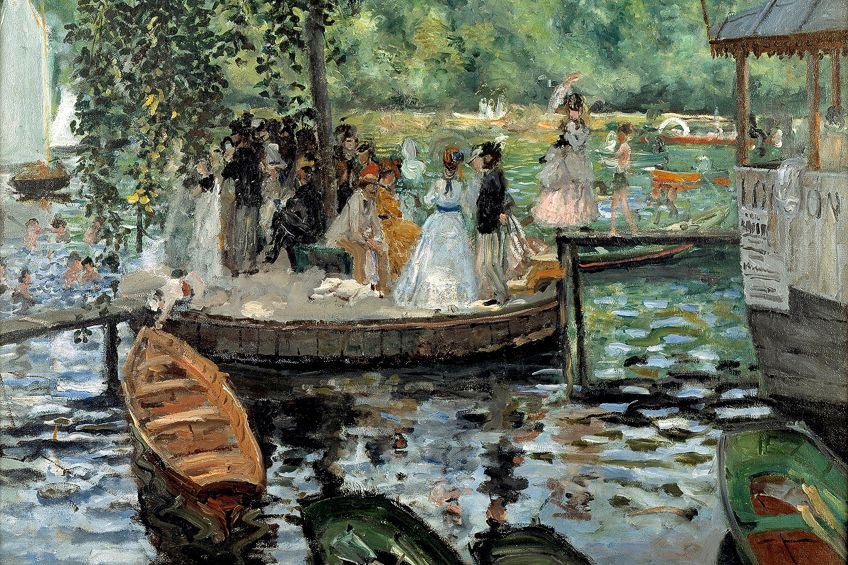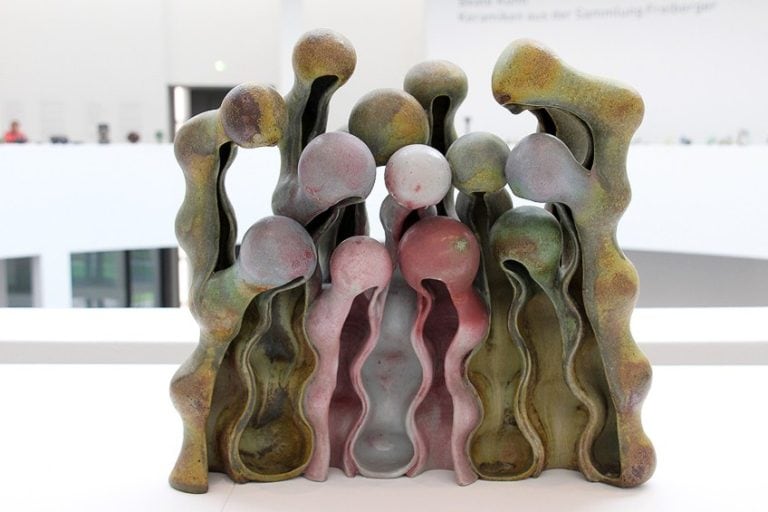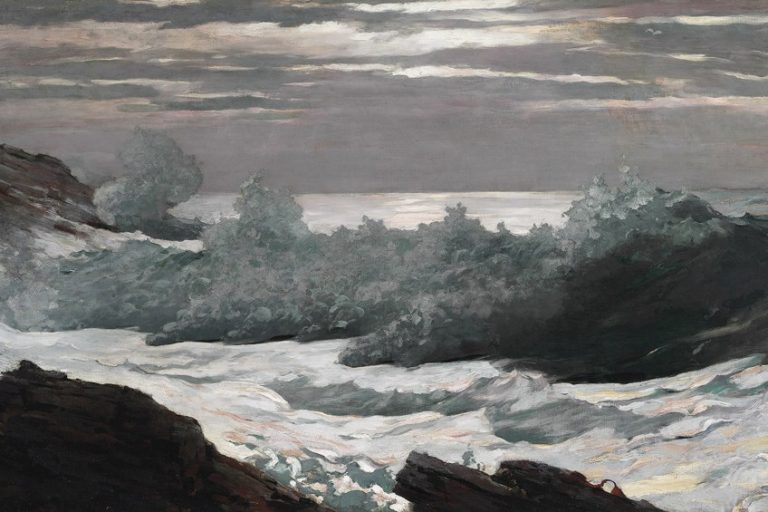Impressionist Painters – 12 Famous Masters of Impressionism
Existing as a 19th-century art movement, Impressionism began in France after a group of artists expressed the desire to paint landscapes and contemporary life instead of historical and mythological scenes. This rejection of traditional salons and exhibitions by the Impressionist group was considered to be radical, as art history had only witnessed grand subjects at that point. With works being characterized by small, yet visible brush strokes, artists working within this period went on to create some of the most iconic artworks known today.
Table of Contents
- 1 A Brief History of the Impressionist Movement
- 2 Key Characteristics of the Impressionist Movement
- 3 Our List of the Most Famous Impressionists
- 3.1 Camille Pissarro (1830 – 1903)
- 3.2 Édouard Manet (1832 – 1883)
- 3.3 Edgar Degas (1834 – 1917)
- 3.4 Alfred Sisley (1839 – 1899)
- 3.5 Paul Cézanne (1839 – 1906)
- 3.6 Marie Bracquemond (1840 – 1916)
- 3.7 Claude Monet (1840 – 1926)
- 3.8 Jean Frédéric Bazille (1841 – 1870)
- 3.9 Berthe Morisot (1841 – 1895)
- 3.10 Pierre-Auguste Renoir (1841 – 1919)
- 3.11 Mary Cassatt (1844 – 1926)
- 3.12 Gustave Caillebotte (1848 – 1894)
- 4 Frequently Asked Questions
A Brief History of the Impressionist Movement
During the middle of the 19th century, the type of art that was being created was incredibly traditional, as artists produced works that would fit the conventional salons and exhibitions that were being held. However, a small group of artists began to experience a great deal of boredom with the kind of artworks they were required to make and started to branch out in terms of their subject matter. Suddenly, the outdoors held great appeal for artists, who began painting what became known as en plein air paintings, whereby artists painted outside.
After these newly experimental artworks were rejected by the Salon, these Parisian-based artists soon formed their own society during the 1870s and 1880s, known as “Société Anonyme Coopératives des Artistes Peintres, Sculpteurs, Graveurs.” This was done so that they could showcase their developing style and freely exhibit their artworks in a space where they were fully accepted. In essence, this proved to be a major turning point for the movement, and thus the style of Impressionism was born.
Heralded as a daring new movement within the art world, Impressionism existed as an exciting time for artists that was full of trial and error.
With its name being derived from Claude Monet’s 1872 painting, titled Impression, Sunrise, the movement was said to only truly end after the death of Monet in 1926. However, Impressionism appeared to be a relatively short-lived period, as its popularity began to fade out once a diluted form of Impressionism had become accepted in Salon art.
Despite this, Impressionism went on to inspire a variety of emerging art movements, with its painting style widely considered to be a precursor of some notable art periods. These subsequent movements, which all had a great impact on the development of art history, included Neo-Impressionism, Post-Impressionism, Fauvism, and Cubism.
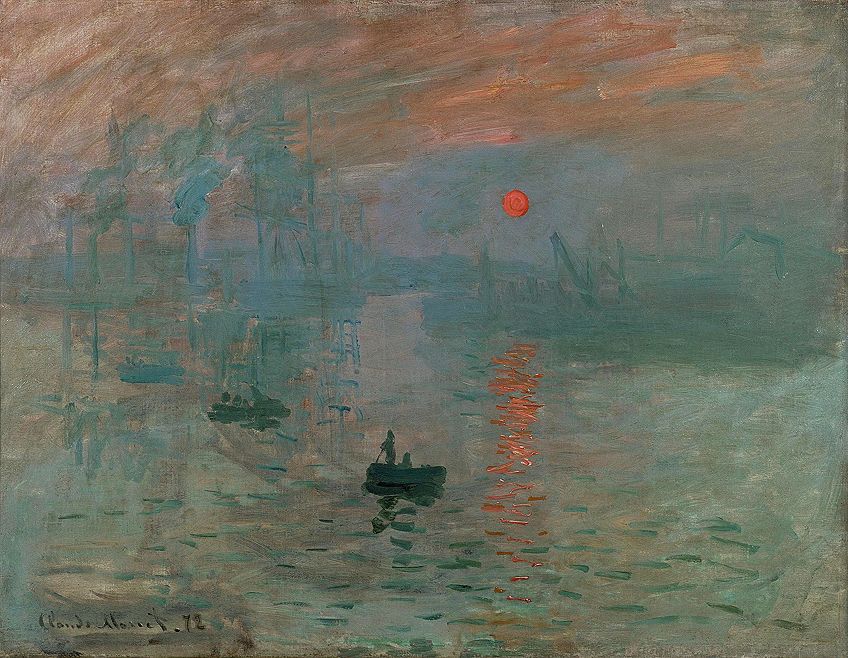
Impression, Sunrise (1872) by Claude Monet; Claude Monet, Public domain, via Wikimedia Commons
Key Characteristics of the Impressionist Movement
Impressionism was better thought to capture contemporary life at the time, as the movement demonstrated a preference for everyday scenes and ordinary people as subjects as opposed to traditional portraits of upper-class patrons. Thus, a main characteristic of Impressionism was that artists began to paint mostly outdoors and “on the spot”, so as to accurately capture nature as it was progressing before their own eyes.
Artists focused on the key elements of light and motion and worked on ways to manipulate these aspects in their paintings.
This change in subject matter allowed artists to break free from the customary imagery in art that typically depicted religious scenes or the wealthy, in favor of commonplace views of the French country and city that constantly surrounded them. As Europe had only witnessed one type of subject in art at that point, this development of Impressionism was seen as a major change. The common man was suddenly celebrated and seen as a worthy subject matter, which was a great step forward for French painting at the time.
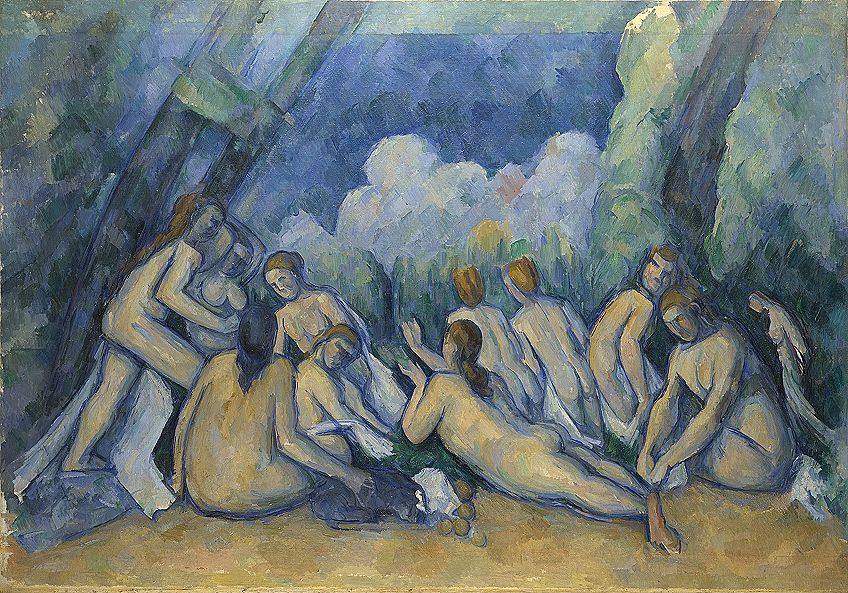
In order to accurately capture what artists saw in the world around them, a much looser and lighter brushwork technique was adopted. This was done so artists could create an “impression” of the scene around them by paying particular focus on the way that light interacted with the world. Exploring how light and shadow interacted with the landscapes was best done through natural light, which was the main reason that artists chose to paint outside.
Another important characteristic of Impressionism was its relationship with color, as vibrant tones were chosen. Very little detail was given to subjects, as artists placed focus on creating soft yet visible brushstrokes to create the illusion that there were no brushstrokes at all. Places of emphasis were created by the light touches of pure and intense colors, which added to the temporal qualities associated with light.
Due to this, Impressionism was said to change the course of art history, as it set the stage for the later emergence of Modern Art.
Our List of the Most Famous Impressionists
As the Impressionist movement grew in popularity, many artists began to experiment with this exciting new art style. Because of this, many notable artists went on to create equally iconic Impressionist artworks. However, we have chosen our top 12 most famous Impressionist painters of all time to discuss, who all created timeless masterpieces of art and are all considered to be great pioneers of the movement.
Camille Pissarro (1830 – 1903)
| Nationality | Danish-French |
| Where the Artist Lived | France |
| Associated Art Movements | Impressionism and Post-Impressionism |
| Most Famous Artworks | Entrée du village de Voisins (1872) Hoar Frost, the Old Road to Ennery, Pontoise (1873) Boulevard Montmartre (1897) |
Belonging to both the Impressionist and Post-Impressionist art group was Danish-French artist Camille Pissarro, who made important contributions to both movements. Pissarro was seen as the transitional figure between these two groups, as his signature technique of short and rough brushstrokes seemed to better fit the Post-Impressionist movement as his style developed. Some of his most well-known works include Entrée du village de Voisins (1872), Hoar Frost, the Old Road to Ennery, Pontoise (1873), and Boulevard Montmartre (1897).
Born on the island of St. Thomas, which is now known as the Virgin Islands, Pissarro was encouraged by his father to draw scenes of nature from a young age. At the age of 21, he pursued art full-time, moving to Venezuela where he worked as an artist for two years, finding inspiration in the landscapes and villages. Pissarro eventually returned to Europe and settled between Paris and the countryside, where he continued to produce art until he passed away in 1903.
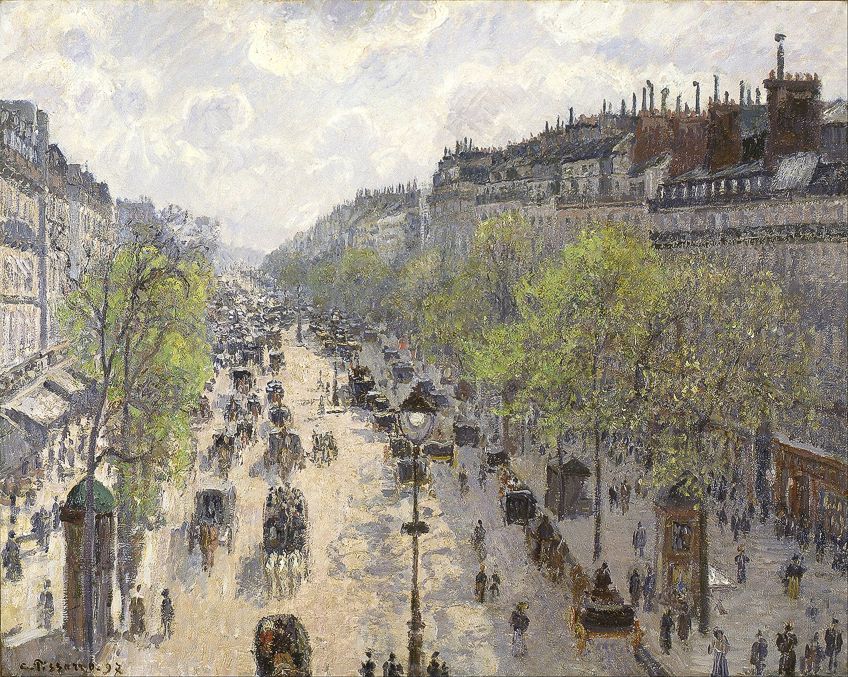
Pissarro was influenced by artists of the current Realist movement, such as Gustave Courbet and Jean-Baptiste-Camille Corot in his early years. Later, at the age of 54, he studied and worked under the supervision of Post-Impressionist artists Georges Seurat and Paul Signac. Helping establish the initial group of Impressionists, Pissarro was nicknamed the “dean of the Impressionist painters” as he was the oldest, possessed the most wisdom, and was considered to be the most compassionate with a kind-hearted personality.
Seen as incredibly ambitious and unwavering in his artistic endeavors, Pissarro’s artworks explored the relationship between light and color, which was something that he manipulated within most of his paintings. This understanding of these two concepts was informed by his time in Caracas, Venezuela, where he examined nature and peasant life in tropical conditions.
Through his extensive studies, Pissarro managed to capture the ordinary lives of the common folk through his delicate depictions of rural subjects, which he painted in vivid compositions.
Pissarro was heavily swayed by the politics of society at the time, as his artworks could not be divorced from political influences at all. This could be seen in his paintings, as they dignified the work of peasants in communal villages, which reflected the socialist-anarchist political leaning of the time.
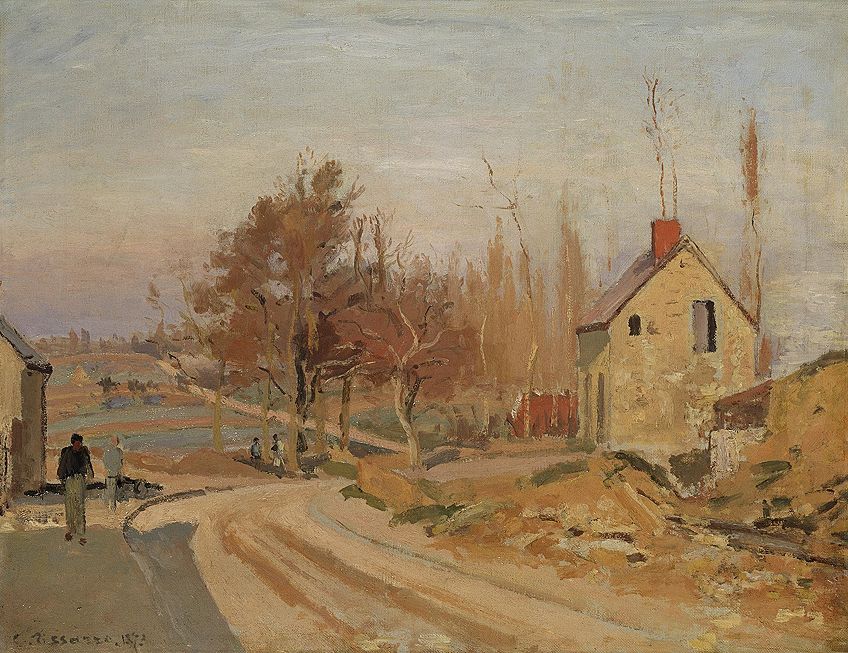
Pissarro was one of the most notable Impressionist artists due to the fact that he was the only artist from the entire movement to showcase all of his artworks at all eight Impressionist exhibitions in Paris between 1874 and 1886. This represented his great status within Impressionism, with fellow artist Pierre-Auguste Renoir going on to refer to him as utterly “revolutionary” within the movement.
In his later years, Pissarro worked closely with Seurat and Signac, going on to become one of the earliest artists who experimented with color harmonies. His canvases were identified by his complementary colors, along with his broken, dashed, and choppy brushstrokes and abrupt dabs of paint. Unlike other Impressionist artists who lived in Paris, Pissarro chose to spend the majority of his time in the French countryside, where he taught younger artists who expressed an interest in his techniques.
Pissarro is remembered for his significant contribution to the Impressionist movement as he had an essential influence on the emergence of 20th century Modernism, in addition to his passionate experimentation that made for truly unique artworks.
Édouard Manet (1832 – 1883)
| Nationality | French |
| Where the Artist Lived | France |
| Associated Movements | Realism and Impressionism |
| Most Famous Artworks | Music in the Tuileries (1862) The Luncheon on the Grass (Le déjeuner sur l’herbe) (1863) Olympia (1863) |
Born in France into an upper-class household, Impressionist painter Édouard Manet was another pivotal figure in the transition period between the Realism movement and the Impressionist movement. Despite being considered as one of the leading Impressionist painters, Manet’s work differed greatly from other artists. His most notable paintings include Music in the Tuileries (1862), The Luncheon on the Grass (Le déjeuner sur l’herbe) (1863), and Olympia (1863).
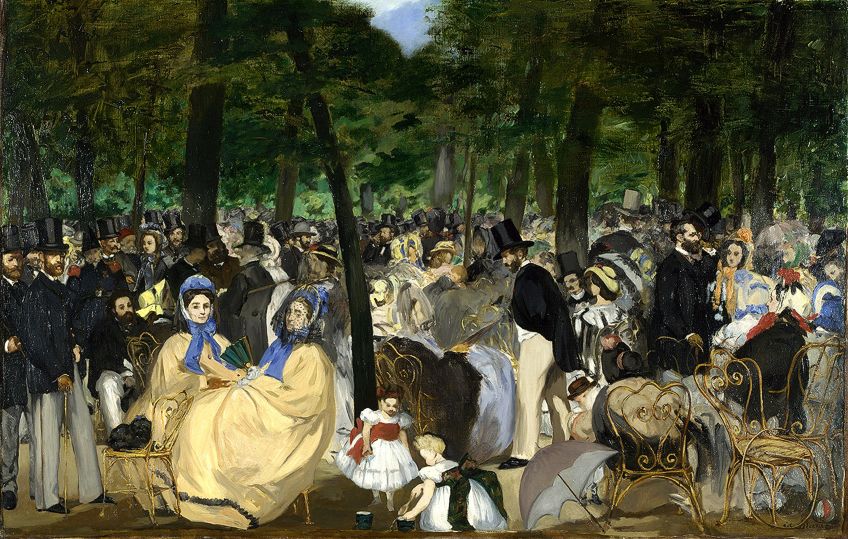
Encouraged to pursue art at an early age, Manet traveled to Italy, Germany, and the Netherlands in order to educate himself and develop his style. His travels heavily impacted his artistic concept, as Manet went on to place great focus on contemporary themes.
His daring and controversial paintings drew great criticism and adoration among the artists of his time, which solidified Manet’s status as an influential artist within the Impressionism movement.
Manet exhibited his 1860 painting, The Spanish Singer, at The Salon in Paris, which went on to be criticized as sloppy and careless. Despite this, his courageous choices in subject matter gained him great notoriety, and he quickly became a significant Impressionist painter. Manet broke tradition by including elements of modern life into his nature scenes, as female nudes became the main subjects in his paintings. However, Manet received serious backlash from his traditionalist peers for his supposedly immoral and obscene paintings of the female nude.
What set Manet apart from other Impressionist artists was his unique style of painting. His brushstrokes were incredibly loose, and his formal rendering of volume led to areas of great flatness in his works. Due to his relaxed brushwork, some parts of his canvases were often left uncovered, which caused critics to comment that his paintings always seemed unfinished and had an unpolished feel about them.

Preferring to depict ordinary life and common objects in his paintings, street life and its people proved to be popular subject matters for him. Manet went on to portray Parisian cafes and bars, as well as city and urban life, which gave his paintings a definite Impressionist feel. Additionally, Manet has been recognized for popularizing the technique of alla prima painting, whereby he immediately painted layers of wet paint upon one another to match the final effect he was looking for.
This approach became widely used by Impressionist painters, who felt that it was perfectly suitable for the pressures of having to capture the immediate effects of light and atmosphere while painting outside.
Throughout his career, Manet produced artworks that sparked both admiration and dispute, with his watershed pieces effortlessly marking the start of the new artistic period. Sadly, Manet died at the early age of 51, after contracting syphilis.
Edgar Degas (1834 – 1917)
| Nationality | French |
| Where the Artist Lived | France |
| Associated Movements | Impressionism |
| Most Famous Artworks | The Dance Class (1873 – 1876) The Absinthe Drinker (1876) At the Races (1877 – 1880) |
Another prominent Impression painter was Edgar Degas, who was most famous for his oil paintings and pastel drawing. Degas, who was an Impressionist painter, believed himself to be more of a Realist artist as opposed to an Impressionist, despite being seen as one of the founders of the movement. His most notable works include The Dance Class (1873 – 1876), The Absinthe Drinker (1876), and At the Races (1877 – 1880).
Born into a wealthy family, Degas proved to be an ambitious artist from an early age. Even though he suffered from failing eyesight, Degas underwent years of strenuous training so as to pursue a career in history art. After years of producing historic artworks, Degas transferred his focus to contemporary subjects in his early thirties, which gained him great praise for his paintings.
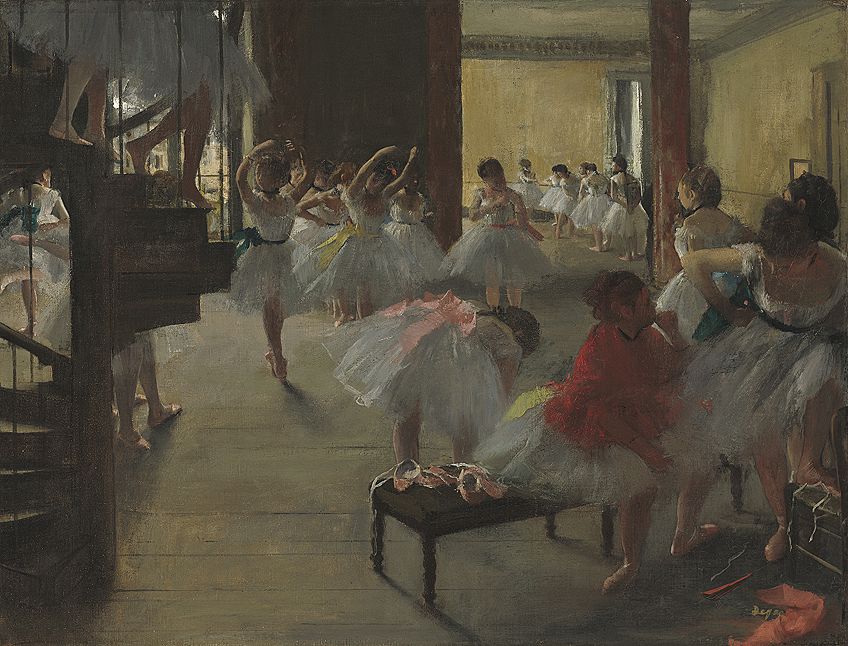
Throughout his career, Degas was widely known for his paintings that depicted horse racing and dance. More than half of his paintings focused on dancers, which demonstrated Degas’ interest in the human figure. This interest was said to be formulated during his academic training, which led to him approaching the female body in a variety of inventive ways.
Degas looked for his subject matters in modern situations, such as the ballet, and displayed his talent at capturing peculiar poses from strange angles under artificial light.
Similar to artist Pierre-Auguste Renoir, Degas did not generally paint outdoors like other Impressionist artists. This led to his rejection of the term “Impressionism”, as he preferred his works to be seen as independent and considered as realist depictions of what he saw. Degas’ paintings mostly consisted of Parisian life, with his main subject matter still consisting of female bodies. In addition to dancers, Degas depicted prostitutes and singers as well, which brought about much criticism from critics due to their seemingly lower-class status.

An interesting and baffling dichotomy existed in the way that Degas addressed his female subjects. A lot of evidence pointed to Degas being a misogynist, yet more evidence existed that proved he was completely captivated with the female form that he attempted to represent in all its beauty through his multiple studies.
Due to this, his portraits were often celebrated for their ability to convey such psychological intricacies, with his paintings furthering the exploration of the figure within visual arts.
Degas conflicted heavily with the approach taken by traditional Impressionist painters at the time, as he preferred to work from sketches and memory, which was considered to be the conventional academic way, as opposed to painting outdoors. His unique paintings were said to capture what would later come to be known as the “decisive moment” in art, whereby the motion in an artwork seemed frozen in time.
Known to be very difficult, Degas stated that an artist could not have a personal life as well as a career and began isolating himself from the outside world, which led to his friends abandoning him. With his failing eyesight, Degas, unfortunately, spent the remainder of his days wandering the streets alone until he went practically blind.
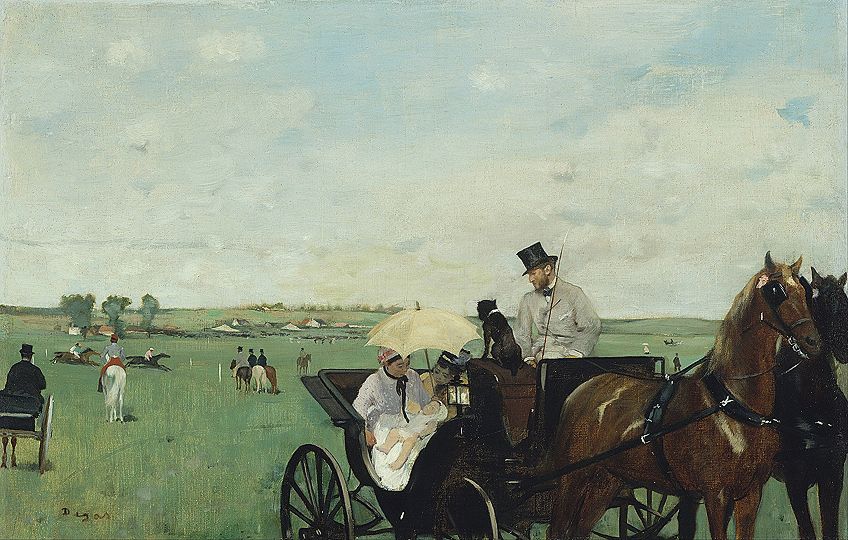
Alfred Sisley (1839 – 1899)
| Nationality | British-French |
| Where the Artist Lived | France |
| Associated Movements | Impressionism |
| Most Famous Artworks | Avenue of Chestnut Trees Near La Celle-Saint-Cloud (1867) Footbridge at Argenteuil (1872) The Bridge at Villeneuve-la-Garenne (1872) |
Seen as one of the more consistent Impressionist painters in the movement, artist Alfred Sisley is remembered for his dedication to painting his landscapes en plein air. Stating that Impressionism fulfilled his artistic needs, Sisley is, unfortunately, one of the more overlooked artists as he rarely strayed from his subject matter of landscapes. Despite this, his more well-known works include Avenue of Chestnut Trees Near La Celle-Saint-Cloud (1867), Footbridge at Argenteuil (1872), and The Bridge at Villeneuve-la-Garenne (1872).
Sisley was born into a very affluent British family in France and frequently divided his time between these two cultures. This division was also attributed to his lack of status during the Impressionist movement, as he constantly worked between these two and never settled on one culture to fully adopt.
Due to this, he remained an outsider for the majority of the movement even though he was a key figure within the development of French Impressionism.
Trained by fellow artists Pierre-Auguste Renoir and Claude Monet, among others, Sisley went on to develop his uniquely Impressionist style as the movement progressed. This helped the issue of his status, as he went on to be seen as one of the crucial painters in the Impressionist movement. His paintings were incredibly exquisite to the modern eye, as his landscapes were known for their astounding ability to accurately capture the feeling of light and atmosphere.
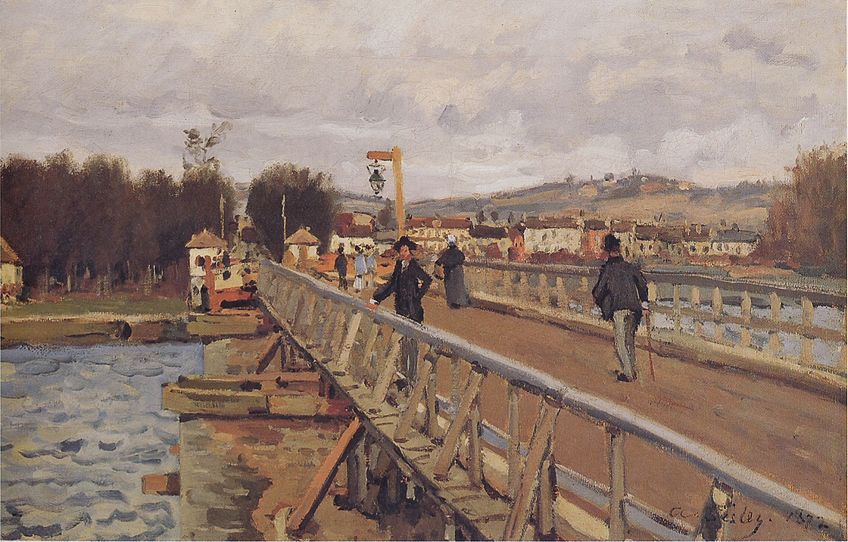
The central feature in the majority of his paintings was his vast and suggestive skies, which always compounded his focus on modern and urban life. Sisley saw nature as a worthwhile subject matter and went on to create countless impressions of what he saw on his canvases through his sketchy brushwork. His technique allowed for the introduction of a new painting style into the newly industrialized world, which demonstrated his importance as an artist.
The delicate sensitivity that Sisley showed to the nuances of natural landscapes was remarkable, as this enabled him to create paintings that came alive with their idealistic emotionalism, as well as their realism. Unfortunately, Sisley’s art did not rise in value until after his death, which led him to die a poor man from throat cancer.
Paul Cézanne (1839 – 1906)
| Nationality | French |
| Where the Artist Lived | France |
| Associated Movements | Impressionism, Post-Impressionism, Romanticism, Cubism, and Modern Art |
| Most Famous Artworks | A Modern Olympia (1873 – 1874) Bend in the Road Through the Forest (1873 – 1875) Landscape near Paris (1876) |
One of the most iconic artists to emerge from the developing art world was Paul Cézanne, who experimented with a variety of different art movements. Cézanne was credited with laying the foundations for the transition between 19thcentury Impression and 20th century Cubism. His most notable Impressionist paintings include A Modern Olympia (1873 – 1874), Bend in the Road Through the Forest (1873 – 1875), and Landscape near Paris (1876).
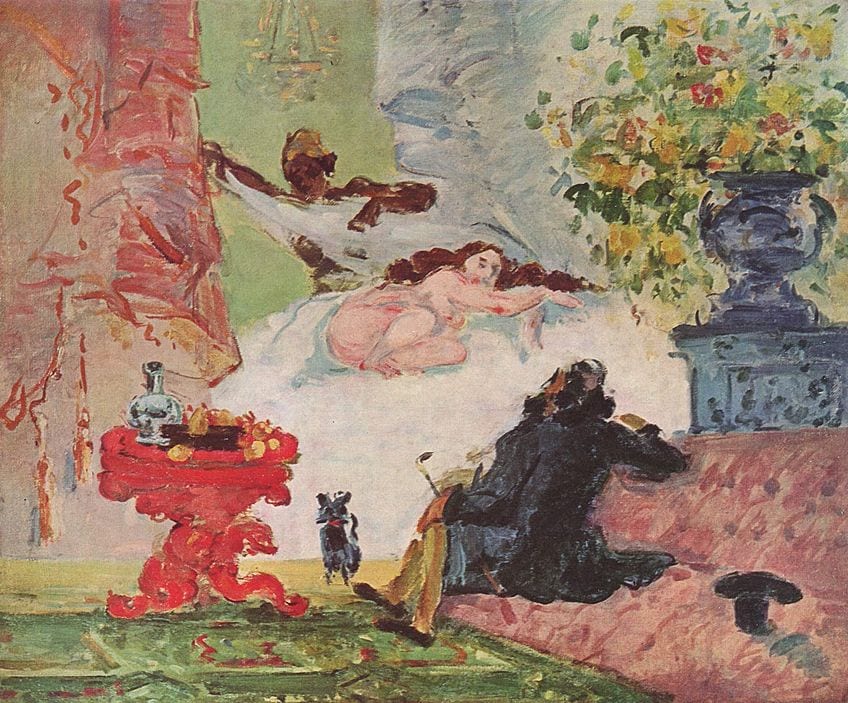
After befriending French playwright Émile Zola whilst still at school, Cézanne was encouraged to pursue his art full-time and moved to Paris to develop his artistic skills. Seen as the leading artist of the Post-Impressionist movement, Cézanne’s art was only appreciated towards the end of his life after he displayed his fascination with art’s material and sculptural origins.
Due to this, the paintings he created during the Impressionist era remain remarkably unknown when compared to his later works.
Becoming unsatisfied that Impressionism was merely a reflection of visual perception, Cézanne began to broaden his artistic practice into a new kind of analytical discipline. In doing so, his canvases took on a role of their own during painting, with his visual sensations only being registered after staring repeatedly at the subject at hand. Cézanne started to apply his colors to his canvas via distinct and methodical brushstrokes, as he stated that he was constructing a picture as opposed to painting what he saw.
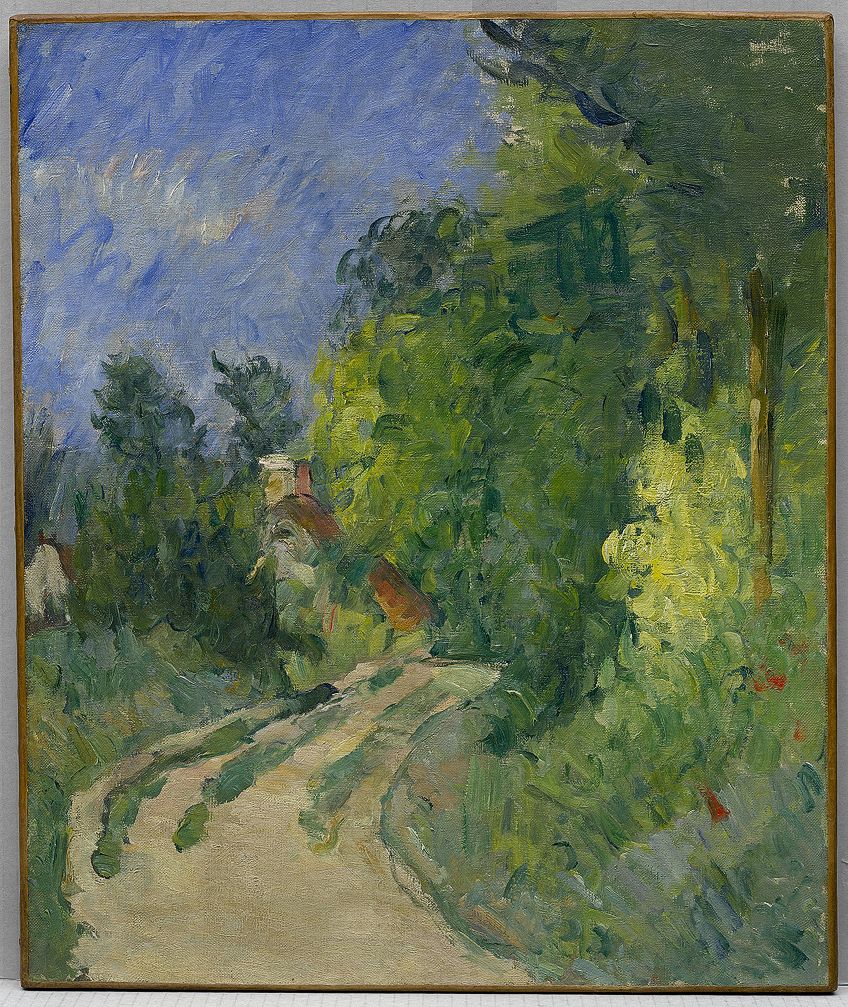
Known for his seemingly monotonous yet characteristic and exploratory brushstrokes, Cézanne managed to capture the true essence of the landscapes that surrounded him. This added to the architectural element that was viewed in his paintings, as he believed that every section of a painting should contribute to the artwork’s general structural integrity. Cézanne made use of small brushstrokes and broad planes of color that allowed him to build up and form complex settings, with his influence on 20th-century art thus speaking for itself.
Reported by both Henri Matisse and Pablo Picasso to be the “father of us all”, Cézanne’s contribution to Modern Art remains unparalleled. His paintings included the essential link that allowed his style to effortlessly move from Impressionism to Fauvism, Cubism, Expressionism, and even complete abstraction.
The focus that Cézanne approached his paintings, no matter if they were still life’s, landscapes, or portraits, allowed him to examine his subjects from every conceivable angle, making him a great mentor within Cubism.
Marie Bracquemond (1840 – 1916)
| Nationality | French |
| Where the Artist Lived | France |
| Associated Movements | Impressionism |
| Most Famous Artworks | Woman in the Garden (1877) Three Women with Umbrellas (1880) Pierre Painting a Bouquet (1887) |
One of the first prominent female artists within the Impressionist movement was Marie Bracquemond, who was considered to be one of the most significant female artists of the time. Known for her playful executions of color and textures, Bracquemond created some incredibly notable works within the Impressionist period. Her most well-known paintings include Woman in the Garden (1877), Three Women with Umbrellas (1880), and Pierre Painting a Bouquet (1887).
Due to her being female, Bracquemond was often overlooked and flew under the radar, with her contribution to art sometimes being omitted from history books. This was said to be partly because of her husband, Félix Bracquemond, who was also a well-known artist at the same time and was said to be extremely envious of her talent.
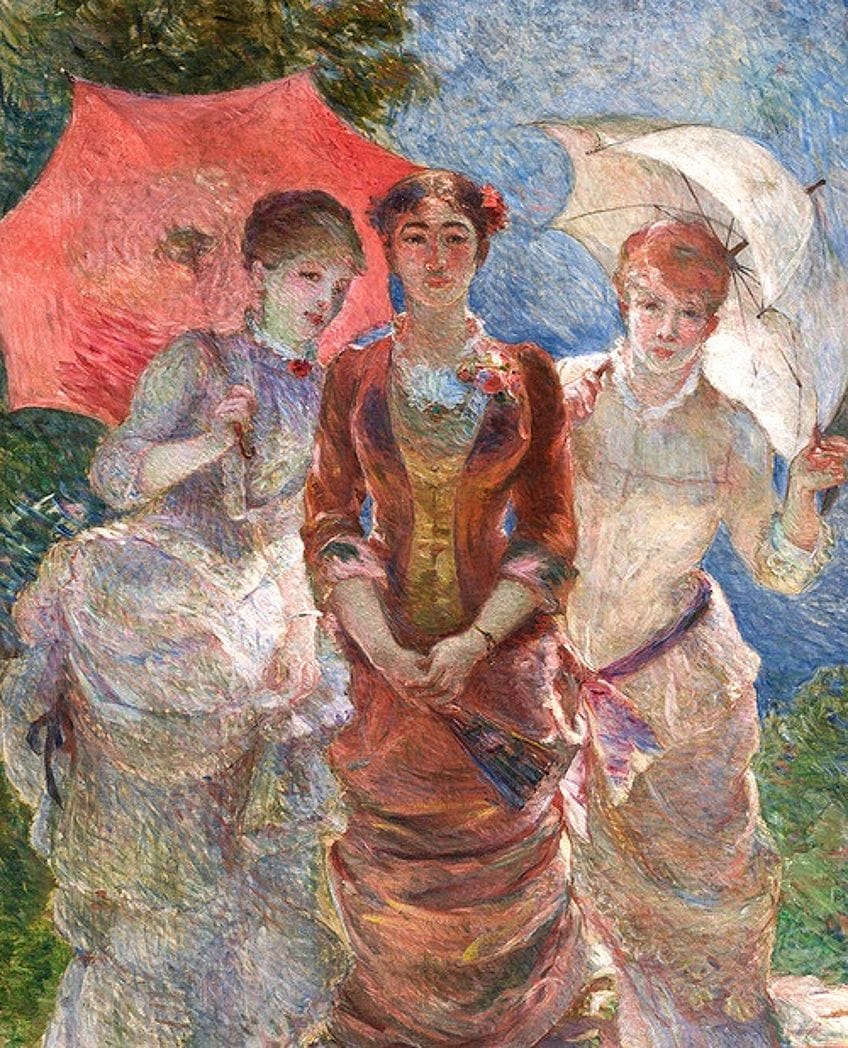
Starting her career as mainly an academic painter, Bracquemond’s extremely refined Realist style was more in line with the ideals of Salon-approved artists and artworks. However, her style began to drastically shift after she met Impressionist painters Édouard Manet and Edgar Degas and she became more absorbed with the principles of Impressionism. By the 1880s, Bracquemond’s painting style and characteristics could only be explained as fully Impressionist.
Acknowledged for her evident luminosity, Bracquemond’s whimsical use of color and texture gave her paintings an unmistakable type of flare to them.
However, after 1886, her style underwent another change, as her color palette became progressively more vivid. This was due to her encounter with Paul Gauguin, who encouraged Bracquemond to enhance her somewhat muted color palette so that it became much brighter.
This change proved to be ironic, as Bracquemond’s husband preferred to work in black and white as opposed to such vibrant colors, but still displayed a great jealously towards his wife’s artworks. As with other famous Impressionists, Bracquemond enjoyed painting outdoors and by the middle of her career, most of her paintings depicted the garden in her home in the southwest of Paris.
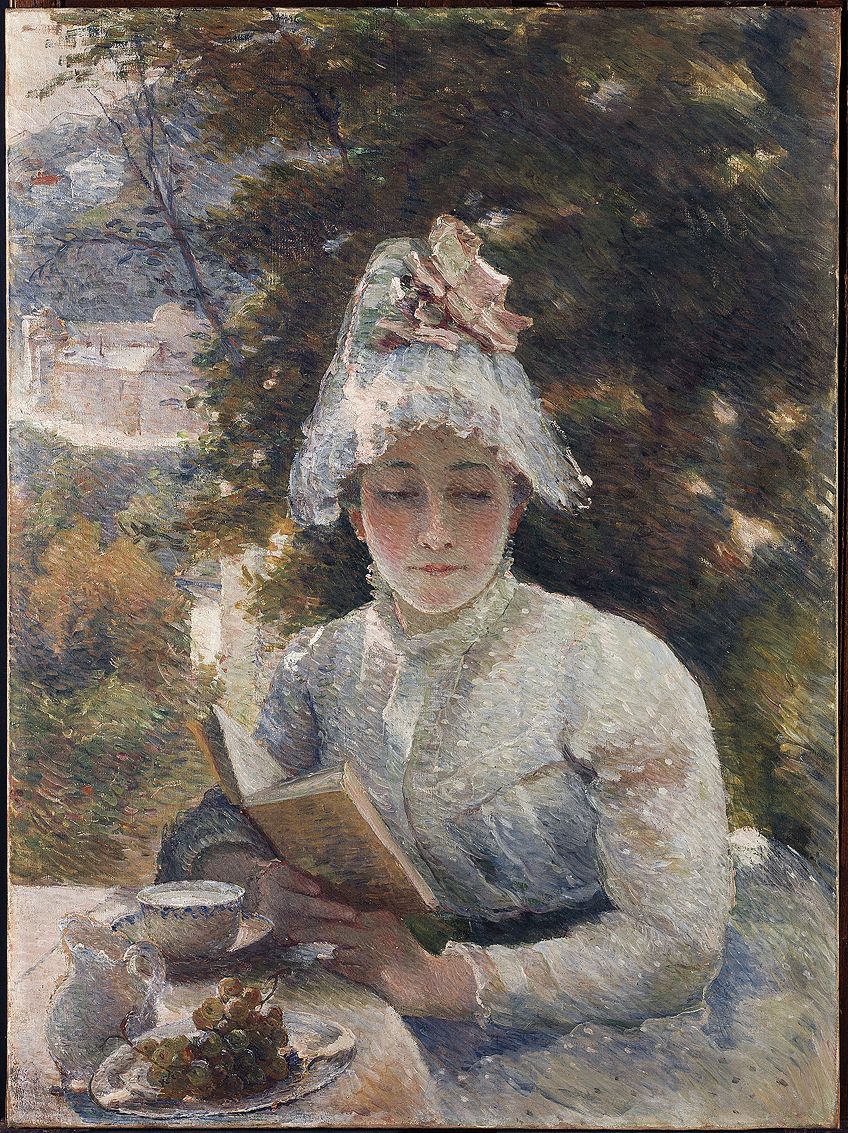
Claude Monet (1840 – 1926)
| Nationality | French |
| Where the Artist Lived | France |
| Associated Movements | Impressionism |
| Most Famous Artworks | Impression, Sunrise (1872) The Haystacks (1890 – 1891) Water Lilies (1915 – 1926) |
Perhaps the artist best known within the Impressionist movement is its founder Claude Monet, who was also considered to be a key precursor to the development of Modernism in art. The title of the movement was derived from his iconic 1872 painting, Impression, Sunrise, with the movement only truly coming to a close after Monet’s death. In addition to this painting, other iconic works include The Haystacks (1890 – 1891) and Water Lilies (1915 – 1926).
Seen as one of the most prolific and consistent proponents of Impressionism, Monet upheld the philosophies of Impressionism through his dedication to painting en plein air.
Landscapes proved to be his most popular subject matter, with Monet being able to accurately convey the authenticity and perception of nature through his paintings. Monet’s fixation with capturing nature as accurately as possible proved to be very overwhelming, which led to him painting the same scene countless times so that he could portray the changing light and seasons.
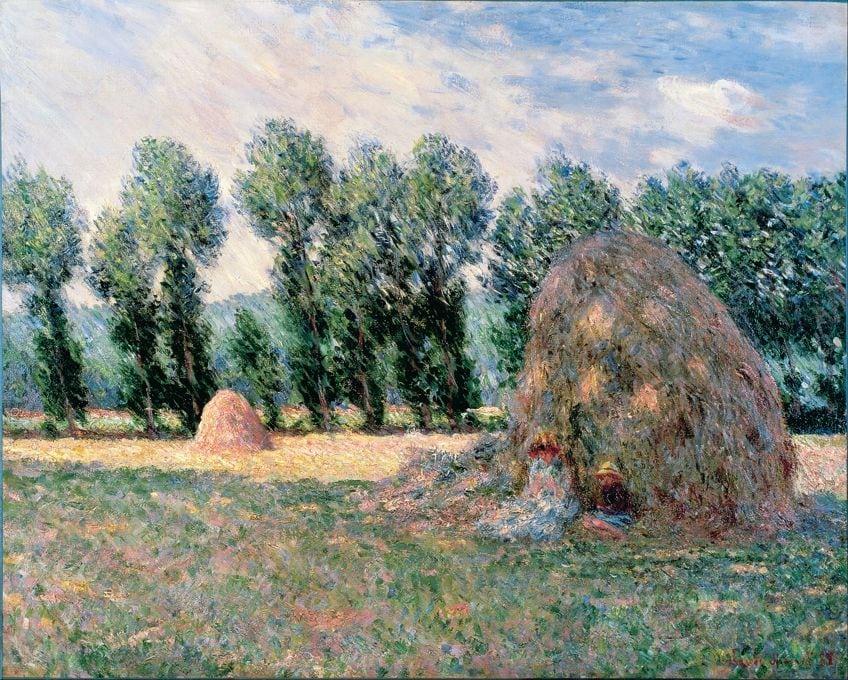
Known for his extensive studies of light and color, Monet displayed a preference for creating series and returned to the same themes often so as to capture them at different times of the day and in different seasons. This is most notable seen through his series on the cathedral in Rouen, France, and his haystack paintings.
Greatly inspired by Édouard Manet, Monet was not interested in the notions surrounding conventional art and demonstrated a clear departure from form, linear perspective, and other established art forms of the time. Instead, Manet experimented with bold colors that he loosely painted in his incredibly uncommon compositions, as well as making use of contrasting and complementary colors and smaller strokes of paint.

As a landscape artist, Monet emphasized the shifting qualities of light and atmosphere in the different scenes that he depicted. He became increasingly sensitive to the decorative qualities that color could have on light as his career went on and began to apply paint in reduced strokes so as to build up fields of broad color. This allowed Monet to explore all of the possibilities, harmonies, and contrasts that color provided, which enabled him to move towards abstraction and a more modern style of painting by the start of the 1890s.
Considered to be a great influence and essential leader of the Impressionist painters, Monet played a crucial role in recruiting Alfred Sisley, Édouard Manet, Camille Pissarro, and Pierre-Auguste Renoir to practice within the Impressionist period.
Monet also helped in establishing an exhibition society that would go on to showcase the group’s artworks between 1874 and 1886, which helped with the advancement of Impressionism.
Jean Frédéric Bazille (1841 – 1870)
| Nationality | French |
| Where the Artist Lived | France |
| Associated Movements | Impressionism |
| Most Famous Artworks | The Fontainebleau Forest (1865) Bathers (Summer Scene) (1869) Bazille’s Studio (L’atelier de Bazille) (1870) |
One of the most radical artists in the early 1860s, who was an Impressionist painter also, was Jean Frédéric Bazille. Responsible for helping lay the foundations for the Impressionist movement along with Claude Monet, Édouard Manet, and Pierre-Auguste Renoir, Bazille helped to turn the conventional artistic establishment on its head with their innovative and new approach to painting. Some of his most significant works include The Fontainebleau Forest (1865), Bathers (Summer Scene) (1869), and Bazille’s Studio (L’atelier de Bazille) (1870).
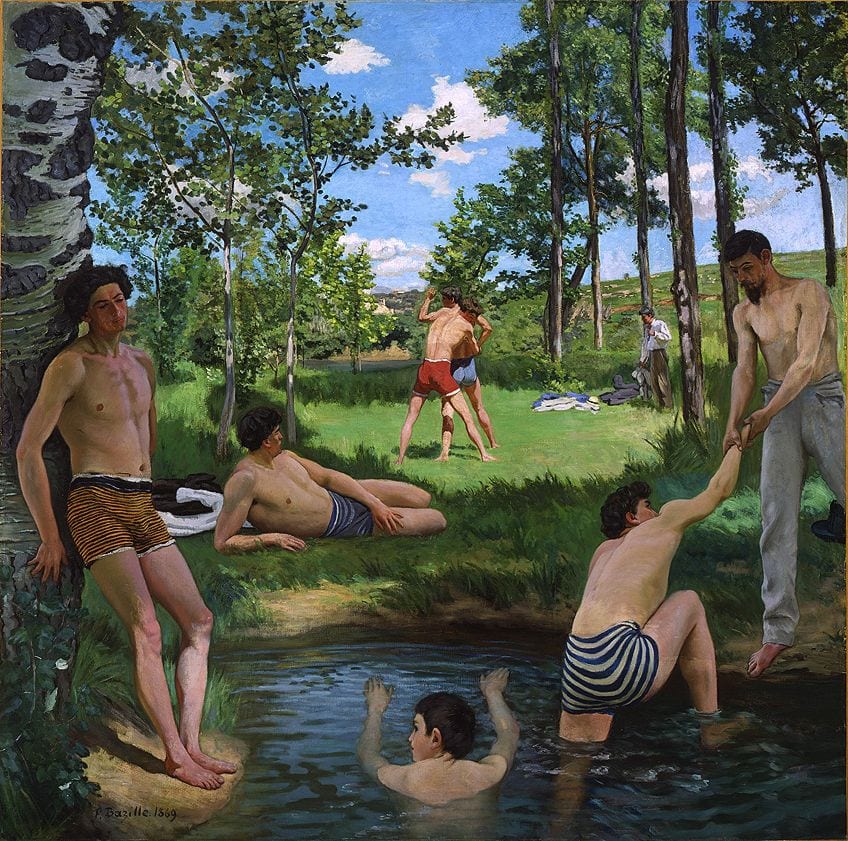
Born into a wealthy family, Bazille was expected to become a doctor by his family. After seeing the artworks of Eugène Delacroix, Bazille expressed a deep interest in painting. His family agreed to indulge in his artistic side, provided that he continued to pursue a career in medicine. This led to him choosing to study both medicine and art at the same time and after failing his medical exams, he decided to take up painting full time.
Due to his affluent status, Bazille used his money to help support his fellow Impressionists when exhibitions continued to turn them down. Encouraged by Monet to paint outside as opposed to in his studio, Bazille began to frequently paint in the countryside with nature and landscapes becoming his most prominent subject matter.
His works tended to focus on figures, and he placed his efforts on successfully integrating human figures into his Impressionist yet Modern landscapes.
Bazille’s artworks quickly moved into a more extremist artistic terrain, as he began to incorporate modern compositional tactics, such as uncommon cropping of pictures to mimic a photograph, within his harmonious compositions. Due to this, Bazille’s painting style appeared to be both restrained and loose at certain points, depending on the angle of his works and the type of brushstrokes used.
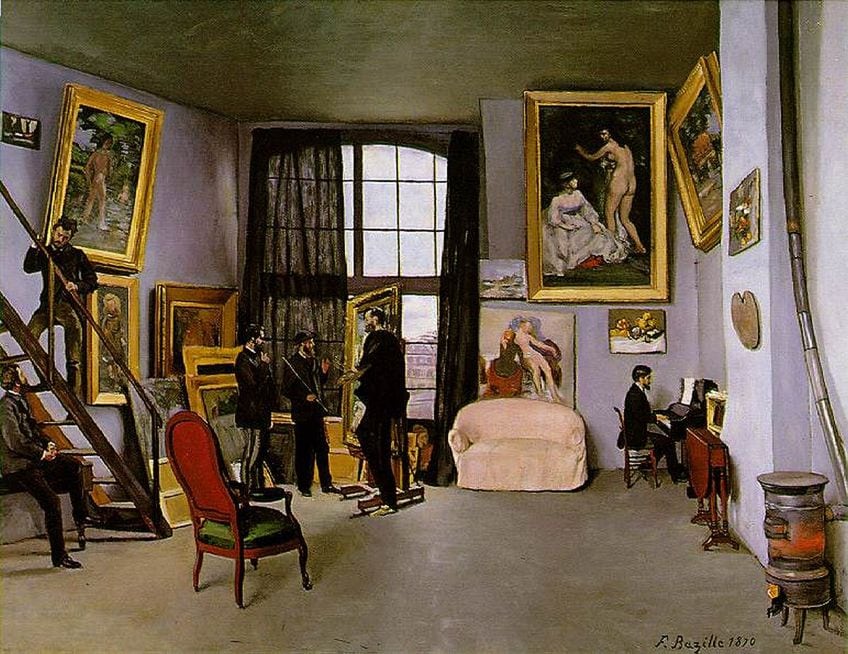
What set Bazille aside from his Impressionist contemporaries was that his color palette was generally darker than the majority of other Impressionist paintings and that he included starker contours and surfaces that were even.
He is often considered to be the artist that had exquisite timing yet terrible luck, as he remained relatively unknown during the Impressionist period compared to other artists.
In 1870, Bazille enlisted for the Franco-Prussian war and joined the army. Sadly, he passed away at the tender age of 28, before he ever got the chance to exhibit his artworks at the first-ever Impressionist exhibition. Despite none of his artworks being put on display at the eventual exhibition that took place, Bazille is still considered to be a fundamental artist to the Impressionist movement.
Berthe Morisot (1841 – 1895)
| Nationality | French |
| Where the Artist Lived | France |
| Associated Movements | Impressionism |
| Most Famous Artworks | The Cradle (1872) Young Girl in a Ball Gown (1879) The Port of Nice (1881 – 1882) |
Another incredibly well-known female Impression painter was Berthe Morisot, who became one of the integral members of the inner circle of Parisian Impressionist artists. Seemingly borrowing characteristics from just about every Impressionist artist to exist, Morisot’s artworks were credited with “feminine charm” in an art age that was dominated by men. Some of her more noteworthy paintings include The Cradle (1872), Young Girl in a Ball Gown (1879), and The Port of Nice (1881 – 1882).
Married to Édouard Manet’s brother, Eugène Manet, Morisot practiced as an artist alongside her husband. Her artworks were often romantic and gentle in nature, as her whimsical feminine talent helped arouse a sense of intimacy within her paintings. Morisot remained a consistent member of the Impressionist group, as she went on to participate in all but one of the eight Impressionist exhibitions that took place between 1874 and 1886.
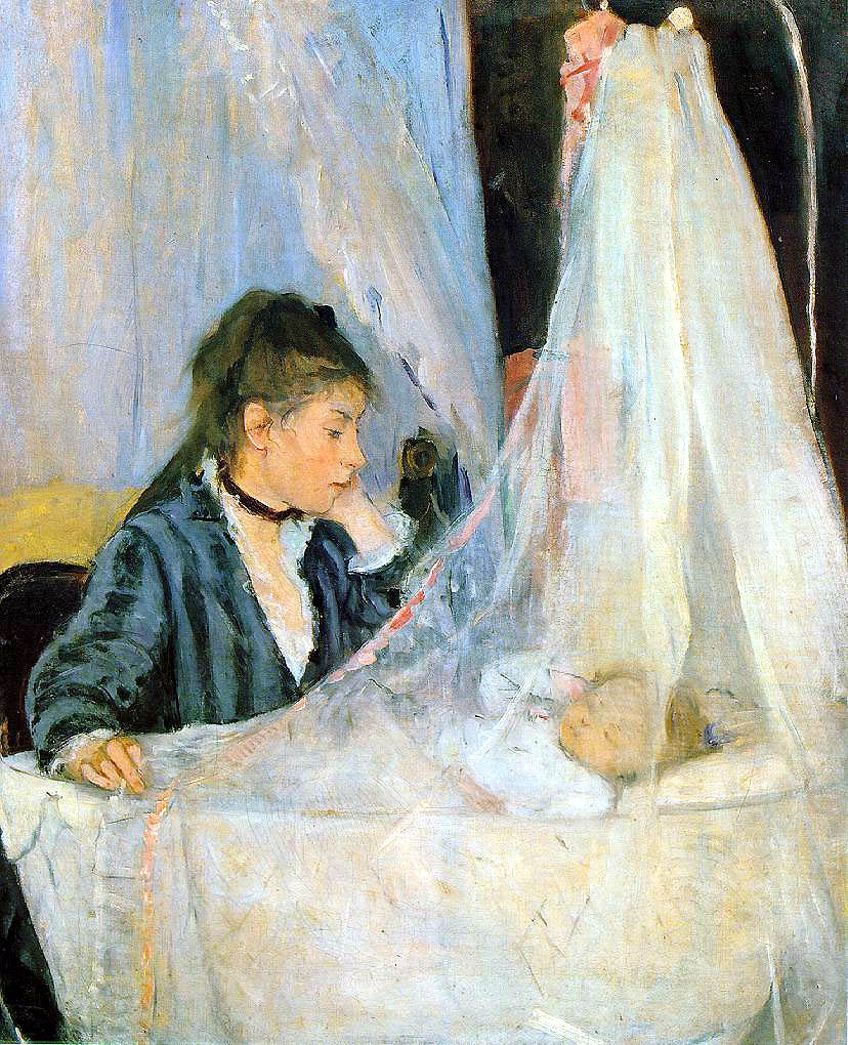
Despite being considered as one of the inner-circle Impressionist painters, Morisot was unfortunately banned from accessing the complete range of subject matter that was available to her male counterparts due to her status as a woman. This included the scruffier areas of urban life, such as cafés, bars, cabarets, and brothels, which led to her focusing mainly on landscapes and more contemporary street and urban scenes.
Conversely, Morisot’s subject matter revealed her access to all aspects of feminine life in the 19th century, such as the inclusion of private and intimate scenes, that were barred from men. This led to Morisot being labeled by critics as too sensitive and submissive for the art world, with these titles traditionally being pinned on women within this male-centered period of history.
This makes Morisot’s contribution to art that much more important, as she existed as so much more than a mere female voice within a male-dominated art movement.
Her artistic style was incredibly influential, with other well-known Impressionist painters referring to her as “master colorist” due to her paintings. Morisot began her career by producing watercolors and drawings before eventually moving on to oil paintings, where her style was characterized by light, almost fluffy brush marks that seemed to be hastily applied in winding strokes.
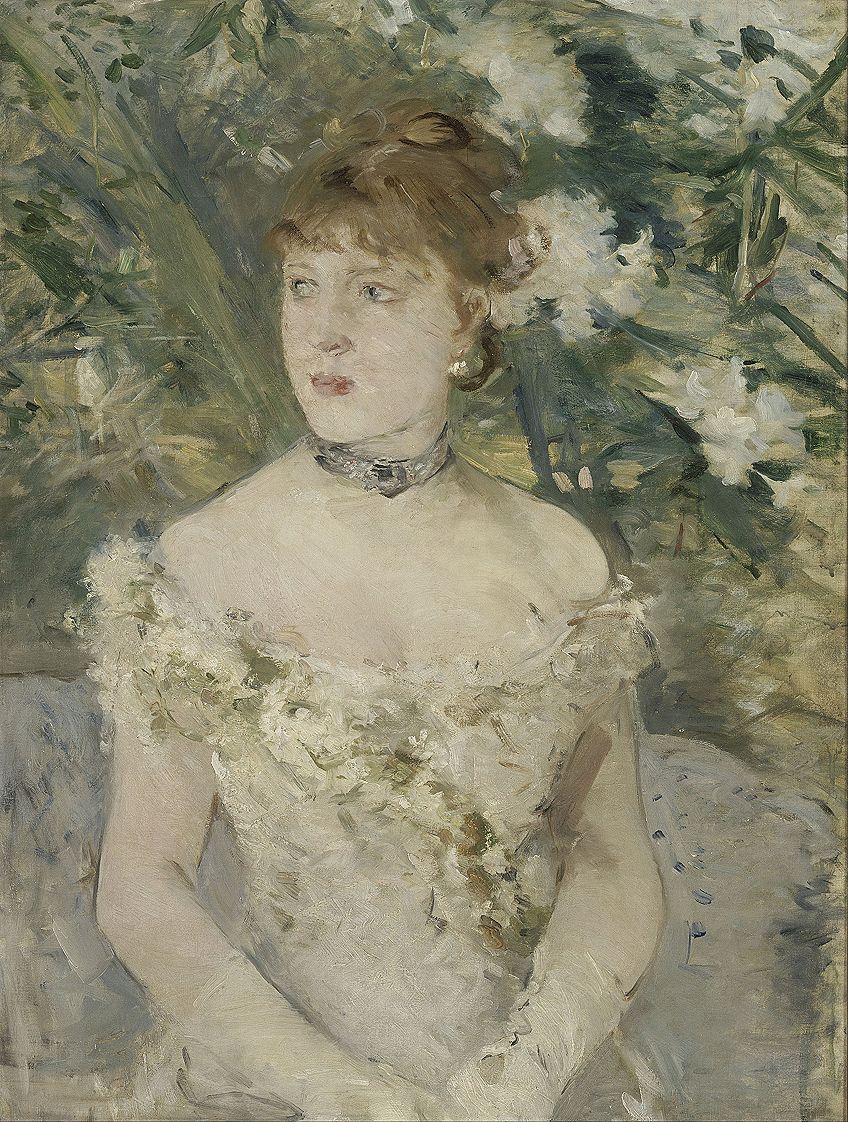
, Public domain, via Wikimedia Commons
Like most other female artists during this period, Morisot favored landscapes and women as her main subjects. She was fortunate enough to not only marry into an artistic family but to have a husband who wholly supported her career by giving up his own artistic endeavors so as to manage her career.
Morisot demonstrated an enthusiastic appreciation of public taste throughout her career and as a result, her paintings sold well during her lifetime and after her death. Her talent and skill eventually won her the admiration and respect of her male colleagues, who began to consider Morisot as their equal.
This was an incredibly uncommon achievement during this time, demonstrating the influence that Morisot’s artistic aptitude had on the Impressionist movement.
Pierre-Auguste Renoir (1841 – 1919)
| Nationality | French |
| Where the Artist Lived | France |
| Associated Movements | Impressionism |
| Most Famous Artworks | La Grenouillère (1869) Pont-Neuf (1872) Luncheon of the Boating Party (1881) |
Another of the famous Impressionists was Pierre-Auguste Renoir, who worked closely alongside Claude Monet in the 1860s to develop the iconic style of Impressionism. Regarded as one of the most beloved Impressionists, Renoir was a leading artist within the movement who had an eye for beauty and celebrated feminine sensuality. Among his most well-known Impressionist artworks are La Grenouillère (1869), Pont-Neuf (1872), and Luncheon of the Boating Party (1881).
Born into a poor family, Renoir moved to Paris so that he could practice and experiment with his developing artistic style. After meeting artists Alfred Sisley, Frédéric Bazille, and Claude Monet, he entered the world of Impressionism. Known for his striking color palette, Renoir typically focused on intimate and honest subject matters, such as the female nude, in his early years before turning his interest to household and rural scenes. In the 1870s, Renoir joined Monet and began to paint outdoors, capturing the scenery along the Seine river in Paris.
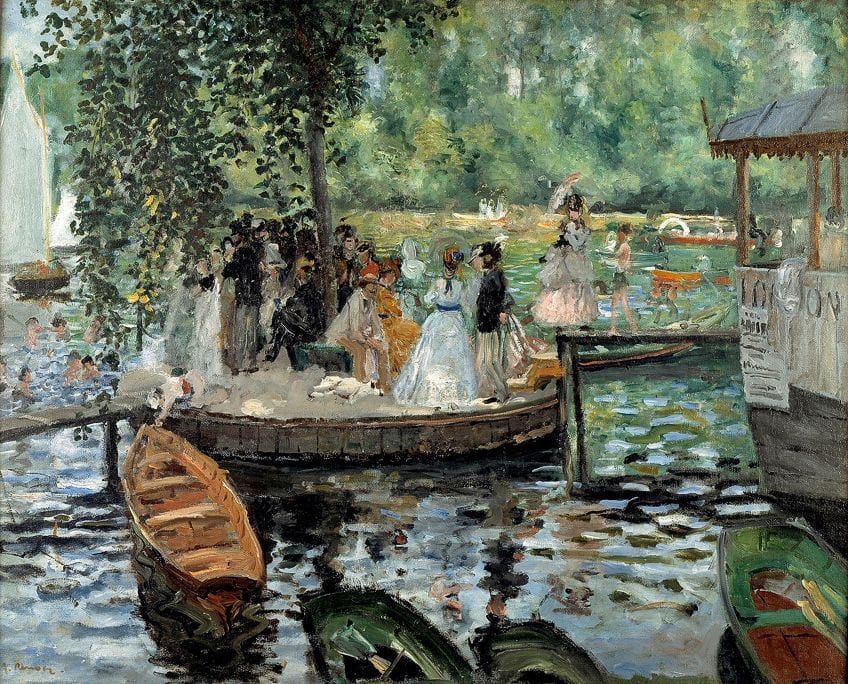
Apart from landscapes, Renoir demonstrated a preference for women and children as his subject matter, which explained why painting en plein air was not as crucial for him as it was for other Impressionist painters. What set Renoir’s artworks aside from other artists was the unquestionable human element that he added to his works, as he had a fantastic eye for capturing both the intimate family lives of scenes as well as the fashions of the time.
Renoir’s images of well-dressed Parisians managed to create a bridge between middle-class society and Impressionism’s more exploratory artistic aims.
His obvious style was often distinguished by the gentleness, fullness, and passion that he included in his paintings. Out of all the famous Impressionists, his paintings are seen as the more “traditional” within the movement, as his landscapes and city scenes tended to capture incredibly cheerful and easygoing occasions of modern Parisian life.
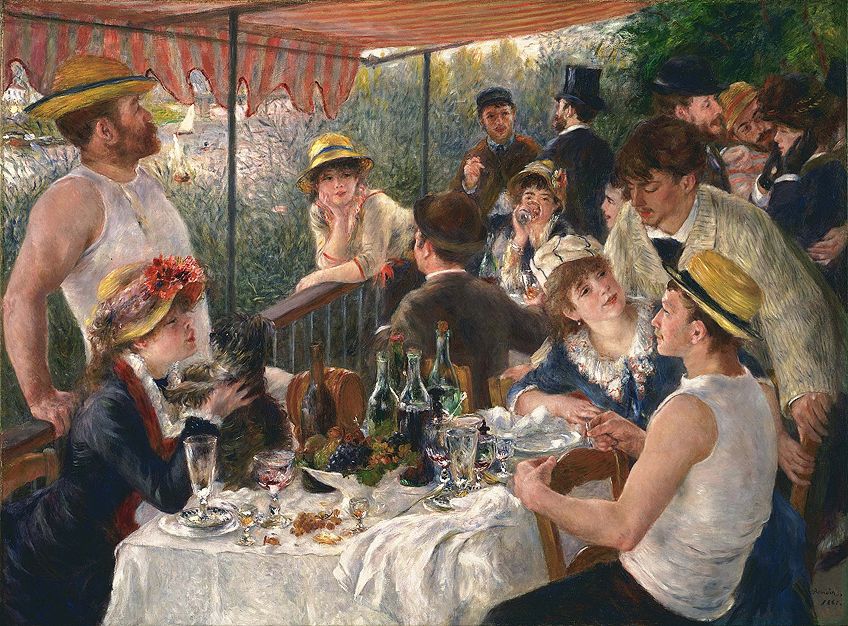
Celebrated for his special eye and skills that magnificently captured light and shadow in his timeless classics, Renoir’s paintings were always full of life and vivid colors. He continued to incorporate his new skills into his multicolored brushstrokes and bright atmospheres as he continued to learn throughout his career, which made his paintings extremely pleasant to look at.
However, it was Renoir’s particular fascination with the human figure and his elegant depiction of form that set him apart from other Impressionist painters of the time.
Renoir was the first Impressionist who was able to recognize and understand the limitations of an art style that was primarily based on visual sensation and light effects. His vibrant and lively works also went on to inspire the works of future 20th-century artists like Henri Matisse and Pablo Picasso. Based on his perceptiveness and the beautiful compositions that he produced, Renoir’s contribution to the movement of Impression remains incomparable.
Mary Cassatt (1844 – 1926)
| Nationality | American |
| Where the Artist Lived | France |
| Associated Movements | Impressionism |
| Most Famous Artworks | Woman with a Pearl Necklace in a Loge (1879) The Child’s Bath (1893) The Boating Party (1893 – 1894) |
As the only American painter on our list, and a woman no less, Mary Cassatt was considered to be the best-known female painter of the Impressionist movement. After befriending Edgar Degas when she moved to France, Cassatt began to regularly exhibit her artworks with her fellow Impressionist painters. Her most notable paintings include Woman with a Pearl Necklace in a Loge (1879), The Child’s Bath (1893), and The Boating Party (1893 – 1894).
Initially studying at the Pennsylvania Academy of Fine Arts, Cassatt moved to Paris in 1866 and proved to be a useful link between these two cultural worlds. Through her savvy business skills, Cassatt built up strong friendships and professional relationships with artists, dealers, and collectors in both America and France, which helped her become a prominent figure in the developing 20th-century art world. Additionally, her experimentation with Impressionism helped to establish a taste for Impressionist art with fellow artists in America.
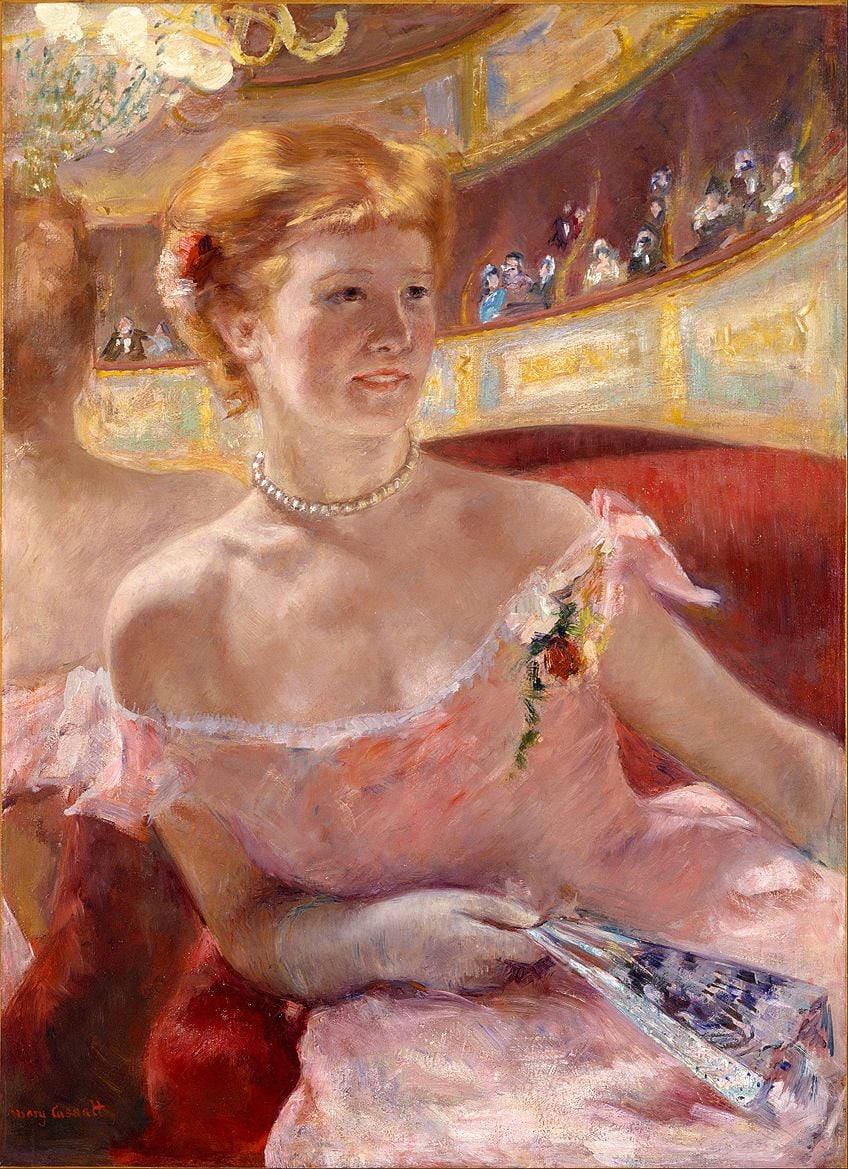
After achieving some professional access when one of her paintings was selected for The Paris Salon, Cassatt hit a bump in her career. It was only after meeting Degas that she joined the Impressionist group, which brought her more professional success and fulfillment from her career.
Considered to be a permanent equal rights advocate, Cassatt abhorred the barring of women in the arts. Due to this, the main subject matter in her paintings focused on women and girls in intimate and domestic scenes, as she typically depicted both the social and private lives of women and mothers with their children.
The reason for including these domestic settings was that they represented the world that she was restricted to as opposed to the more public spaces that her male counterparts were free to occupy and explore.
Cassatt’s paintings effortlessly combined a soft color palette with loose and exquisite brushwork which made her notable among the Impressionists and helped her earn some esteem as a serious artist despite her gender. Despite her art being dismissed as primarily “feminine” at times, most critics realized that Cassatt brought a significant technical ability and psychological understanding to her subject matter, which made her greatly revered.
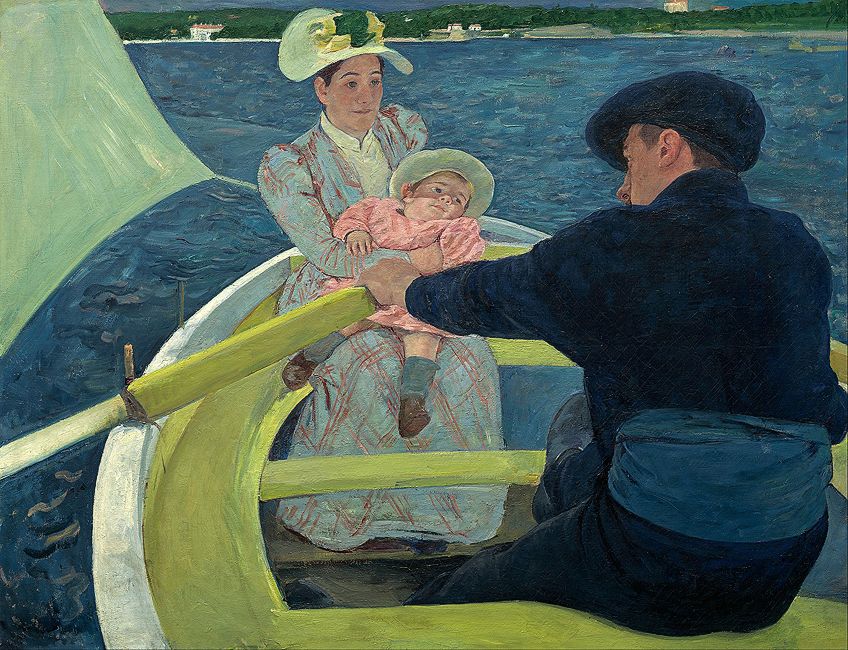
Gustave Caillebotte (1848 – 1894)
| Nationality | French |
| Where the Artist Lived | France |
| Associated Movements | Realism and Impressionism |
| Most Famous Artworks | Le Pont de I‘Europe (1876) Paris Street, Rainy Day (1877) The Garden at Petit Gennevilliers (1893) |
French artist Gustave Caillebotte, who was an Impressionist painter as well, was considered to be more of a Realist artist throughout his career. As he was thought of as one of the foremost Impressionist painters, Caillebotte has unfortunately been unfairly overshadowed by his peers throughout history. Despite this, his works have begun to be exhibited over the last decade, with his most significant paintings including Le Pont de I ‘Europe (1876), Paris Street, Rainy Day (1877), and The Garden at Petit Gennevilliers (1893).
Born into a wealthy family, Caillebotte was able to live off of his inheritance, which allowed him to produce art without any financial worries.
As the anxiety of having to sell his artworks did not affect him, Caillebotte was free to buy the paintings of his fellow Impressionist artists and finance the numerous Impressionist exhibitions. For decades after he died, Caillebotte was known as the biggest financial supporter and patronage of his colleagues, which included his friends Claude Monet, Pierre-Auguste Renoir, Édouard Manet, and Camille Pissarro.
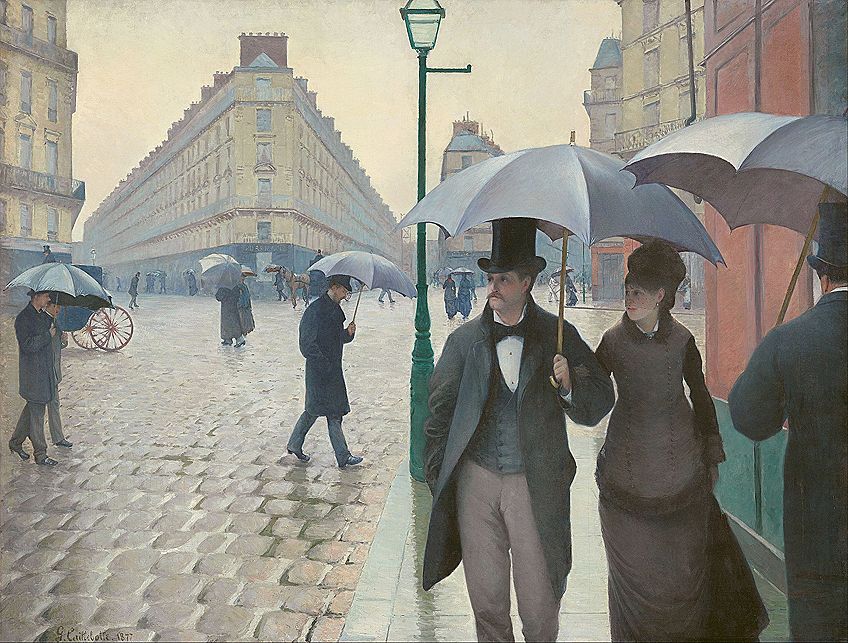
Unlike his contemporaries, Caillebotte exhibited a more realistic style in his artworks. Some canvases were even said to be photo-realistic, as he had this uncanny ability to capture an accurate scene just as a photograph would. His most popular subject matter included interior scenes, cityscapes, and rural scenes, as Caillebotte was able to employ extreme lines of perspective that ignited his paintings with energy within these scenes.
The eccentricity of his style may explain why his artworks were mostly disregarded until the 1950s, and not fully valued and admired by art historians until the 1970s. After his death, Caillebotte was better known as an important donor of Impressionist and Post-Impressionist artworks to the French State as opposed to a notable Impressionist painter himself. Caillebotte even donated a large number of his own paintings at the time, which proved to be an invaluable idea once his artworks received the long-overdue recognition they deserved.
Despite existing as a relatively short movement that expanded into Post-Impressionism, the Impressionist period provided some of the most iconic paintings seen within the history of art. While many more famous Impressionist artists exist, we have merely covered the most notable members of the artistic period. If you have enjoyed reading about these artists, we encourage you to further research other and perhaps lesser-known Impressionist painters.
Take a look at our Impressionist artists webstory here!
Frequently Asked Questions
Who was the Most Famous Impressionist?
Claude Monet was the most famous impressionist known for capturing the effects of light and color in nature with works like Impression, Sunrise.
What are the Main Characteristics of Impressionism?
The main characteristics of impressionism include capturing fleeting effects of light, emphasizing the use of vibrant colors, depicting outdoor scenes, employing loose brushwork, and focusing on subjective interpretations rather than precise details.
How did Impressionist Painters Choose their Subjects?
Impressionist painters often chose their subjects from everyday life, focusing on outdoor scenes like landscapes, gardens, and city streets. They sought to capture the effects of light and atmosphere, emphasizing the transient and spontaneous aspects of their surroundings.
Isabella studied at the University of Cape Town in South Africa and graduated with a Bachelor of Arts majoring in English Literature & Language and Psychology. Throughout her undergraduate years, she took Art History as an additional subject and absolutely loved it. Building on from her art history knowledge that began in high school, art has always been a particular area of fascination for her. From learning about artworks previously unknown to her, or sharpening her existing understanding of specific works, the ability to continue learning within this interesting sphere excites her greatly.
Her focal points of interest in art history encompass profiling specific artists and art movements, as it is these areas where she is able to really dig deep into the rich narrative of the art world. Additionally, she particularly enjoys exploring the different artistic styles of the 20th century, as well as the important impact that female artists have had on the development of art history.
Learn more about Isabella Meyer and the Art in Context Team.
Cite this Article
Isabella, Meyer, “Impressionist Painters – 12 Famous Masters of Impressionism.” Art in Context. June 21, 2021. URL: https://artincontext.org/impressionist-painters/
Meyer, I. (2021, 21 June). Impressionist Painters – 12 Famous Masters of Impressionism. Art in Context. https://artincontext.org/impressionist-painters/
Meyer, Isabella. “Impressionist Painters – 12 Famous Masters of Impressionism.” Art in Context, June 21, 2021. https://artincontext.org/impressionist-painters/.


